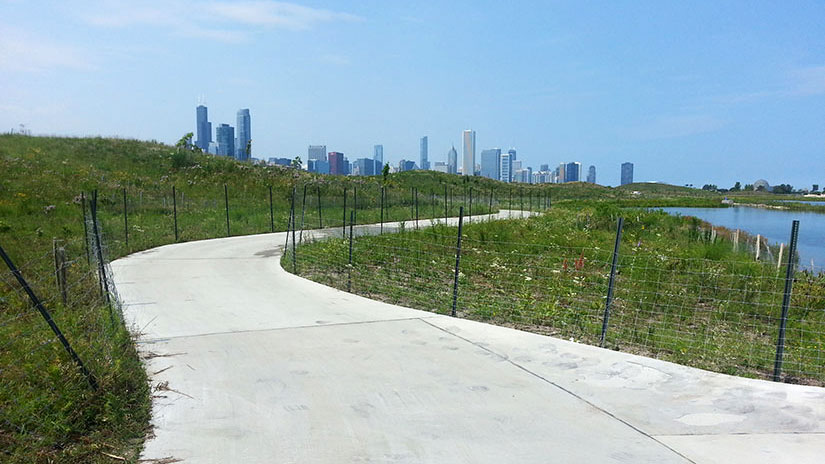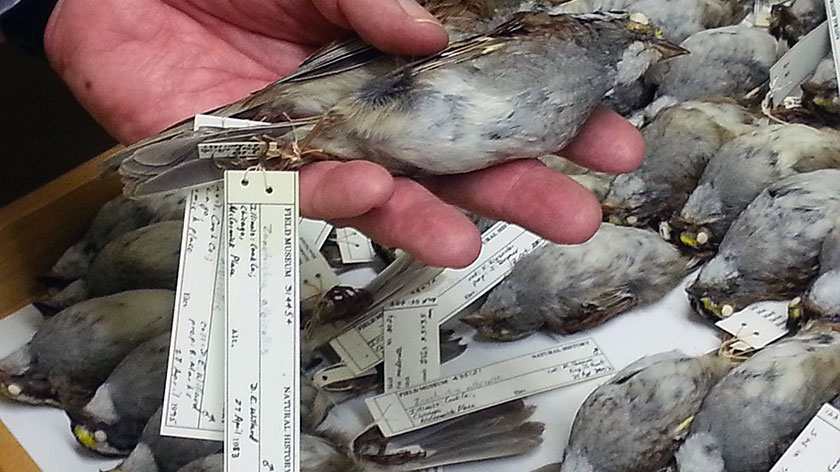Building a Bird-Safe City | Chicago
Chicago is a dangerous place…for migrating birds. But now scientists, architects, and dedicated volunteers are teaming up to make the city a leader in bird-friendly design and policy.
While Chicago’s nighttime skyline offers a spectacular view for people, it can be a deadly vision for migrating birds. Thousands of birds are injured and killed here in building collisions each year during spring and fall migration.
Located on the Mississippi Flyway, Chicago lies along a critical migratory route for millions of birds flying between the northern United States and Canada—where they spend the warmer months—and Central and South America—where the birds overwinter.
While bird species like pigeons and sparrows are familiar with the urban cityscape, hundreds of migrating bird species from rural areas become easily confused by the unfamiliar sight of glowing skyscrapers and gleaming glass windows.
Ornamental lighting, including clock faces and flashing antennas, shine up into the sky from building tops and fatally draw birds down from their migratory routes into the path of buildings. Others fly in circles before eventually falling out of the sky from fatigue.
In an effort to protect migrating birds, the City of Chicago, the Chicago Audubon Society, and the Building Owners and Managers Association launched the Lights Out Chicago program in 1995.
The program recommends turning off decorative lighting on tall city buildings at 11 p.m. daily during the migration seasons, which run from March through June in the spring, and August through November in the fall. In addition, the Lights Out guidelines recommend dimming lobby lighting in buildings that have glass atriums with plants, trees, and other indoor vegetation from 1:00 a.m. until daylight. Migrating birds mistakenly fly toward these lobbies with the hopes of entering a welcoming refuge, and instead collide with a glass barrier.
Highly reflective glass can also prove catastrophic, as birds crash into mirror-like windows when flying toward what appears to be a continuation of the sky.
Chicago-based architect Jeanne Gang of Studio Gang Architects has been designing and constructing buildings with bird-safe features in Chicago and beyond. Gang incorporates “visual noise” elements like pattern-forming balconies and angled, downward-sloping glass, so that birds can easily locate the buildings.
Many birds do survive building collisions, and for more than a decade, the Chicago Bird Collision Monitors have been taking to the city streets to recover and rescue fallen migratory birds.

The organization’s Director, Annette Prince, has been volunteering with the Bird Collision Monitors since 2004. At the time, there were only a handful of monitors. Now Prince leads more than 100 volunteers who canvas the streets of downtown Chicago for dead and injured birds well before sunrise during migration seasons.
On a typical morning, Prince and the other volunteers run frantically through dark streets to remove injured birds from streets and sidewalks, before cars—or predators like gulls—descend on the city. During peak migration seasons, the monitors sometimes recover hundreds of birds in a single morning.
The monitors place injured birds in paper bags and drive them out to the suburbs for evaluation and treatment at the Willowbrook Wildlife Center. Once rehabilitated, the birds that are able to complete a successful flight test are banded and released onsite. Miraculously, between 60 to 70 percent of the injured birds that the Bird Collision Monitors send to Willowbrook are eventually released.
Dead birds collected by the Collision Monitors are sealed in plastic bags and sent to The Field Museum, where the birds are preserved as research specimens. A visit to the museum’s Bird Division reveals hundreds of drawers filled with dead bird specimens. Each specimen is tagged to identify the species, and the date and location at which it was discovered.
Thousands of the museum’s specimens never actually made it past the lakefront into the heart of downtown Chicago. The first menacing urban obstacle for a migrant is often the massive McCormick Place Lakeside Center, an impenetrable wall-like structure that sits on the city’s Lake Michigan shoreline.
McCormick Place is the largest convention center in the United States and has proven to be one of the biggest bird killers in Chicago. According to Field Museum Senior Conservation Ecologist Douglas Stotz, the Field Museum has been taking tabs of dead birds at McCormick Place for nearly 40 years, during which time it has collected more than 35,000 total specimens to date. However, since becoming a participant in the Lights Out Chicago program, McCormick Place has decreased its bird mortality rate by 80 percent, Stotz said.
In order to further deter birds away from McCormick Place and downtown buildings, migratory bird habitat has been created near the convention center at the Burnham Wildlife Corridor, the McCormick Bird Sanctuary, and at Northerly Island.
Located on the same 91-acre manmade peninsula that once housed the Meigs Field airport, Northerly Island is now home to hundreds of species of wildflowers, grasses, trees, shrubs, and plants that provide food and shelter.
Migratory bird collisions are not limited to Chicago—between 500,000,000 and a billion migrating birds are killed annually in building collisions across the United States. With the ongoing efforts led by Lights Out Chicago, Studio Gang Architects, the Field Museum, the Chicago Bird Collision Monitors, and others, Chicago is providing a model for cities nationwide and across the globe to adopt bird-safe strategies.
“The buildings are not going to go away,” said Prince. “If people can be convinced that it’s better for birds and that this is what happens to all of these different birds, I just hope to raise enough awareness that future architects are going to build buildings more responsively and that lighting practices are going to become more bird-friendly. That’s an easy thing to do, turning the lights out after 11 p.m.—it saves energy and money.”

— Sean Keenehan






